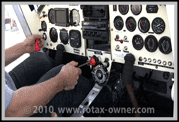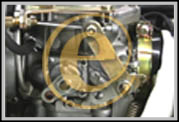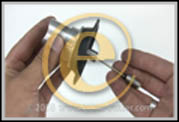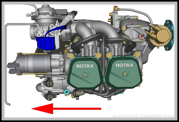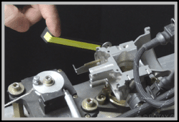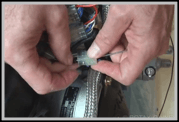A frequent point of discussion seems to be “if the idle isn’t set low enough I can’t land, or I’ll float way down the runway”. The Rotax operator’s manual says the idle rpm should be no less than 1400 rpm. While you think about this, remember that the manuals are written with different engines and configurations in mind and that you will need to adjust your final thinking to suit your personal aircraft and engine setup.
What do I mean about different configurations? You may have a 912UL 80 HP @ 9:1 compression or a 912ULS 100HP @ 11:1 compression and either one could be with or without a gearbox overload clutch. The 912UL without the overload clutch and a lower compression ratio can handle lower idle rpm’s better than the 912ULS with the higher compression with an overload clutch. Low idle rpm with the 912ULS just causes excessive wear from vibration and pulsation in the gearbox. Warm ups and long idling times in the 912 and 914 series engines should always be above 2000 rpm.
So what should we consider when picking an idle rpm? First think of being nice to your gearbox parts and second is setting the idle rpm so you don’t have to ride the brakes all the time. We have all been told time and time again not to warm up at low idle rpm due to the excessive gearbox wear which usually happens under 2000 rpm. You also don’t want to set too high an idle rpm for starting, as this will make your starts much tougher. The choke and ASM system work best at starts with a lower idle rpm around 1600-1800 rpm. Landing rpm should be your last consideration, and I’ll explain shortly.
So what is the perfect rpm? There isn’t one, but there is an idle rpm range for each to consider. A reasonably good place to be would be between 1600-1800 rpm at operational oil temp and some like the twin 912 Tecnam can be higher due to its overall higher aircraft weight and tendency not to roll as easy as a lighter aircraft. The things that may come into play here are which engine you have and how heavy a plane do you own. Those factors affect how much rpm it takes to make it roll for taxi. Heavy planes would need more and light aircraft less. This part is about saving the brakes or slowing for turns. (Just a quick note; Carbs should be synced at idle along with the higher rpms.)
Here’s the biggy!
The next question is how much does the idle rpm affect my landing?
Not as much as many want to believe and here it’s more about piloting skills.
No one usually sets their idle up excessively high and a 100 rpm difference at normal idle rpms (1600-1800) shouldn't make any big difference in a landing especially if we're talking the difference between 1650 and 1750. Most set their idle rpms around 1600-1900 rpm for the ULS. High idle rpms makes you ride the brakes more on the ground. Being able to achieve a lower idle rpm usually reduces taxi brake use over the higher idle settings.
I will have people swear that an 1800 idle rpm over a 1650 idle rpm makes them float way down a runway or they almost can’t land. We have to go back to Flying 101 in the student flight manuals. What controls the aircraft speed? Is it the throttle or the stick? Way too many tell me it’s the throttle. For the sake of this singular discussion let’s just talk about engine speed from idle rpm and maybe up to as high as 2500 rpm.
The stick controls your speed not the throttle. If you have more rpm (or speed) on landing then pulling the stick back a tad farther will land you at the same speed as if the idle rpm were lower. Try it yourself. Pulling the stick back will increase angle of attack which will increase drag which reduces speed regardless of throttle setting and the plane will settle. This can be done in any phase of flight and is done during landings. We use this during slow flight practice as we pull back on the stick to reduce speed. It's the flare in landing. The plane at idle rpm will lose altitude and settle when the angle of attack and drag are increased. This is normal for jet landings and they leave throttle in to touch. I have many friends that leave a small amount of throttle in their 912’s to touch for better tail and directional control with the prop wash. I’m one of them. It’s not outlandish it’s just a different way and there are and always have been different configurations to land. If you wanted to, you could land at full stall at idle or 2500 rpm. The difference would be just a higher nose up at 2500 rpm because you had to increase the drag and angle of attack which helps reduce some lift to get the speed down to stall.
Try a landing at idle rpm then try one at let's say 2500 rpm. The main difference should be that the stick is farther back with 2500 rpm to help slow the plane, but the touch speed should be the same. If you fail to pull the stick back farther will you glide down the runway and maintain a bit more speed? Of course you will, but that’s piloting skills. On approaches and round out the idle speed will never get to 1600 if it was set there. Depending on the plane, pilot and approach speed the rpm will always be higher and what affects that more than any single item is your angle of attack, which either increases the speed and the loading on the prop - or decreases it. The more landing speed the more the prop turns due to some wind milling added to the idle rpm. So even at idle with a 1650 rpm the engine speed may still be around 2100 and decreasing after you round out or flare to land. You can actually turn the engine off if gliding at a safe altitude and unless you slow down the prop can still turn with the engine off.
Last year this very scenario was presented to a large fly-in group of pilots. Many knew the correct answer, but I was stunned at the number that thought idle rpm controlled their speed. We have had all change their mind after some demos that showed landings with an idle rpm set at 1600 and rpm left right to touch down at 2700 rpm. The only difference was the 2700 rpm group had to have the stick back a bit farther to land at the same speed as the ones set at 1650 rpm. 7 years ago some friends in the UK said they couldn’t land on a 300m grass strip unless the idle was set at 1500 rpm with an aircraft with a 14:1 glide ratio. I challenged them that it can be done at 2700 rpm and on an asphalt runway. We measured off 1000’ and I made 8 landings with 2700 rpm in half that distance. The key points are leave no runway behind you at touch and use the stick to control speed and to land at almost stall. It was quite easy.
In Summary;
What is the perfect idle rpm for a 912 series engine? Well that’s up to you, but most will be in the 1600-1800 rpm range, depending on which 912 engine and aircraft they have. Does having an idle rpm set at 1650 rpm versus 1750 rpm make a difference in landing? Not if you realize it’s the stick that controls the aircraft speed (and prop loading) and not a 100 rpm difference in idle rpm. Lower idle rpm does help for taxi on the ground and if you decide to have a low idle rpm for landing just keep in mind you do have the throttle and shouldn’t just let it idle at low rpms when just sitting on the ground.
This Article contributed by Guest Columnist ROGER LEE

